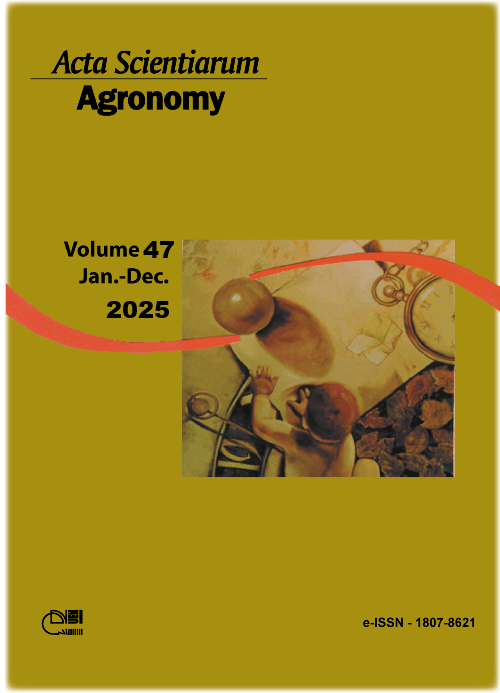Productivity and quality of noble garlic cultivars under different vernalization temperatures
Resumo
Brazilian producers of noble garlic (Allium sativum L.) have sought to enhance the productivity and quality of garlic by applying a vernalization technique that induces bulb formation. The objective of this study was to evaluate the productivity and quality of garlic bulbs produced from different noble garlic cultivars at varying vernalization temperatures. The experiment was conducted in the experimental area of the Wehrmann Agricultural Group and was replicated three times on April 4th (Experiment I), April 18th (Experiment II), and May 16th, 2019 (Experiment III). The experimental design consisted of a randomized complete block design in a 3 × 3 factorial scheme, with nine treatments and four replicates. The treatments consisted of three garlic cultivars: Quitéria, Ito, and Chonan, and three vernalization temperatures (-1 to -3°C; 1 to 3°C; and 2 to 4°C). After harvesting, the bulbs were counted, weighed, and classified based on sieves ranging from 2 to 8, according to the transverse bulb diameter. Following this classification, the commercial, total, and industrial bulb yields were estimated. Negative vernalization temperatures resulted in slower bulb development in all experiments; however, this was associated with a higher potential for bulb growth. Notably, the Chonan cultivar outperformed the other cultivars. Negative vernalization temperature increased the yield of bulbs in the 5–7 and 8 classes (higher commercial value classes), reduced the bulb yields in the 2–4 and industrial classes (lower commercial value classes), and enhanced the total yield.
Downloads
Referências
Azmi, C., Rosliani, R., Handayani, D. P., Jayanti, H., Liferdi, L., & Palupi, E. R. (2022). Temperature and duration of vernalization effect on the vegetative growth of garlic (Allium sativum L.) clones in Indonesia. Open Agriculture, 7(1), 520-528. https://doi.org/10.1515/opag-2022-0114
Bangerth, F. (2000). Abcission of thinning of young fruit and their regulation by hormones and bioregulators. Plant Growth Regulation, 31, 43-59. https://doi.org/10.1023/A:1006398513703
Dufoo-Hurtado, M. D., Huerta-Ocampo, J. A, Barrera-Pacheco, A., la Rosa, A. P. B., & Mercado-Silva, E. M. (2015). Low temperature conditioning of garlic (Allium sativum L.) “seed” cloves induces alterations in sprouts proteome. Frontiers in Plant Science, 6(332), 1-15. https://doi.org/10.3389/fpls.2015.00332
Longhi, C. N., Wilpert, L. S., & Bosco, L. C. (2019). Filocrono de alho nobre cultivado sob influência da vernalização. Agrometeoros, 27(1), 209-216. https://doi.org/10.31062/agrom.v27i1.26581
Lopes, W. A. R., Negreiros, M. Z., Resende, F. V., Lucena, R. R. M., Soares, A. M., Silva, O. M. P., & Medeiros, J. F. (2016). Garlic production depending on vernalization periods and planting times in semiarid climate region. Horticultura Brasileira, 34(2), 249-256. https://doi.org/10.1590/S0102-053620160000200016
Lucidos, J. G., Younis, A., Hwang, Y. J., Son, B. G., & Lim, K. B. (2014). Determination of optimum conditions for breaking bulb dormancy in relation to growth and flowering in Lilium hansonii. Horticulture, Environment and Biotechnology, 55, 257-262. https://doi.org/10.1007/s13580-014-0143-1
Luz, J. M. Q., Azevedo, B. N. R., Silva, S. M., Oliveira, C. I. G., Oliveira, T. G., Oliveira, R. C., & Castoldi, R. (2022). Productivity and quality of garlic produced using below-zero temperatures when treating seed cloves. Horticulturae, 8(2), 1-12. https://doi.org/10.3390/horticulturae8020096
Luz, J. M. Q., Oliveira, C. I. G., Silva, S. M., Oliveira, T. G., & Castoldi, R. (2023). Vernalization temperature and maturation point of seed cloves on garlic production and quality. Ciência e Agrotecnologia, 47, 1-13. https://doi.org/10.1590/1413-7054202347015122
Mazzuco, V. R., Torres Júnior, C. C., & Botelho, G. R. (2023). Fluorescent Pseudomonas spp. and Bacillus spp. for phosphate solubilization and growth promotion of garlic. Pesquisa Agropecuária Tropical, 53, 1-8. https://doi.org/10.1590/1983-40632023v5375301
Michael, T. B., Shemesh-Mayer, E., Kimhi, S., Gershberg, C., Forer, I., Ávila, V. T., Rabinowitch, H. D., & Goldstein, R. K. (2018). Temporal and spatial effect of low pre-planting temperatures on plant architecture and flowering in bolting garlic. Scientia Horticulturae, 242, 69-75. https://doi.org/10.1016/j.scienta.2018.07.025
Mota, J. H., Yuri, J. E., & Resende, G. M. (2014). Produção de alho no estado de Goiás. Nosso Alho, 19, 46-48.
R Core Team. (2023). R: A language and environment for statistical computing. R Foundation for Statistical Computing. http://www.R-project.org/
Reghin, M. Y., & Kimoto, T. (1998). Dormência, vernalização e produção de alho após diferentes tratamentos de frigorificação de bulbilhos sementes. Horticultura Brasileira, 16(1), 73-79.
Siswadi, E., Putri, S. U., Firgiyanto, R., & Putri, C. F. (2019). Peningkatan pertumbuhan dan produksi bawang putih (Allium sativum L.) melalui aplikasi vernalisasi dan pemberian BAP (benzyl amino purin). Agrovigor: Jurnal Agroekoteknologi, 12(2), 53-58. https://doi.org/10.21107/agrovigor.v12i2.5419
Souza, R. J. (2009). Cultura do alho: tecnologias modernas de produção. UFLA.
Taiz, L., & Zeiger, E. (2017). Fisiologia e desenvolvimento vegetal. ARTMED.
Teixeira, P. C., Donagemma, G. K., Fontana, A., & Teixeira, W. G. (2017). Manual de métodos de análise de solo (3. ed.). Embrapa.
Wu, C., Wang, M., Dong, Y., Cheng, Z., & Meng, H. (2015). Growth, bolting and yield of garlic (Allium sativum L.) in response to clove chilling treatment. Scientia Horticulturae, 194, 43-52. https://doi.org/10.1016/j.scienta.2015.07.01
Copyright (c) 2025 José Magno Queiroz Luz, Carlos Inácio Garcia de Oliveira, Sérgio Macedo Silva, João Paulo Diniz dos Santos, Paula Gabriela S. Nunes Souto, Renata Castoldi Castoldi (Autor)

This work is licensed under a Creative Commons Attribution 4.0 International License.
DECLARAÇÃO DE ORIGINALIDADE E DIREITOS AUTORAIS
Declaro que o presente artigo é original, não tendo sido submetido à publicação em qualquer outro periódico nacional ou internacional, quer seja em parte ou em sua totalidade.
Os direitos autorais pertencem exclusivamente aos autores. Os direitos de licenciamento utilizados pelo periódico é a licença Creative Commons Attribution 4.0 (CC BY 4.0): são permitidos o compartilhamento (cópia e distribuição do material em qualqer meio ou formato) e adaptação (remix, transformação e criação de material a partir do conteúdo assim licenciado para quaisquer fins, inclusive comerciais.
Recomenda-se a leitura desse link para maiores informações sobre o tema: fornecimento de créditos e referências de forma correta, entre outros detalhes cruciais para uso adequado do material licenciado.




















































